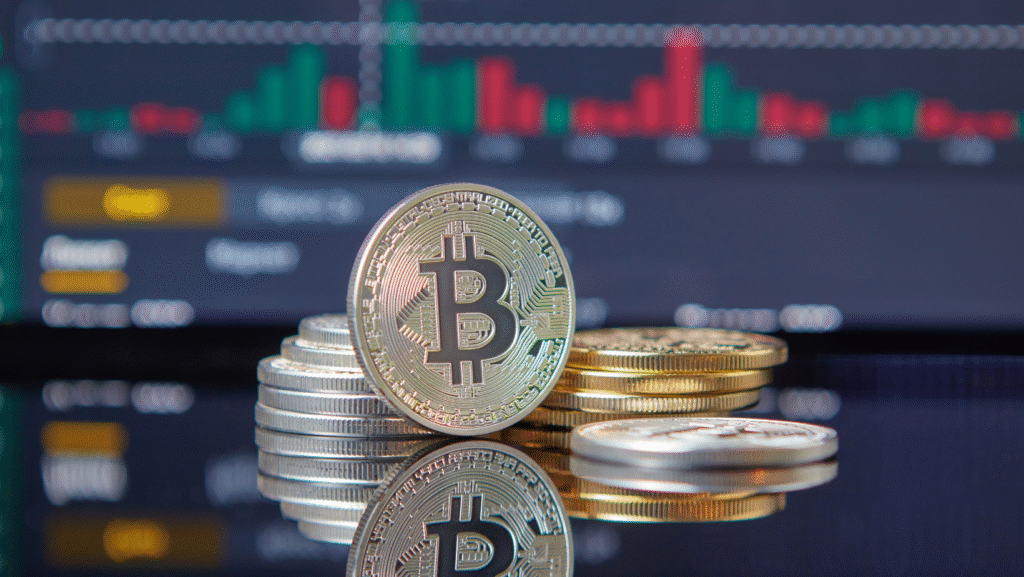Nowadays, when people hear the term Bitcoin, they immediately conjure images of financial revolutions, millionaires, or even wildly fluctuating prices. However, the real narrative of Crypto is far more complex than news reports about its record highs and spectacular falls. It’s the story of visionaries, doubters, daring individuals, and inventors who turned a single piece of code into a trillion-dollar worldwide sensation. This article reveals the little-known history of Bitcoin, how it moved from obscure online forums to making millions of dollars for regular people, and why its narrative is still being told.
Introduction to Bitcoin

What is Bitcoin?
Bitcoin is a revolutionary experiment in economics, technology, and trust. It is more than just digital currency. Crypto runs on a decentralized network, in contrast to conventional currencies that are governed by governments and banks. This implies that it cannot be manipulated by a single entity, such as the European Central Bank or the Federal Reserve. Rather, it is powered by blockchain technology, which is a distributed, transparent ledger in which each transaction is publicly and permanently recorded.
Consider a notebook that is visible to all, but that cannot be changed without the consent of the majority. In essence, that is how crypto operates. People now trust a system outside of traditional banking because of its transparency. It also implies that Crypto can be sent and received by anybody, anywhere in the world, without the need for middlemen.
Why Bitcoin Became a Revolution in Finance

Timing was more important than technology in the growth of Bitcoin. Traditional financial institutions were no longer trusted by the time Crypto emerged in 2009. Ordinary people were bearing the consequences as governments bailed out failing banks. Crypto offered a completely different promise: a peer-to-peer currency that did not rely on the intermediaries that initially created the financial crisis.
Bitcoin was intended to be a movement rather than merely another form of money. It questioned our conceptions of wealth, property, and even freedom. For some, it became a tool of financial empowerment. It was a risky venture for others. Regardless of whether you consider it to be online magic money or digital gold, its revolutionary impact on finance is undeniable.
The Birth of Bitcoin
The 2008 Financial Crisis – A Catalyst for Change
The 2008 financial crisis is essential to understanding the history of Bitcoin. Due to banks’ careless gambling, one of the worst economic disasters in history occurred. While taxpayer funds were used to save financial behemoths, people lost their homes, jobs, and life savings. It appeared like the system was set up to penalize the common people and shield the wealthy.
Let’s talk about Bitcoin. The “genesis block,” the first block in the Crypto blockchain, was mined on January 3, 2009. It contained the now-famous message:
“The Times 03/Jan/2009 Chancellor on brink of second bailout for banks.”
Who Was Satoshi Nakamoto?
Bitcoin was created by an unidentified person or group going by the name Satoshi Nakamoto. Nobody is confident of Satoshi’s true identity to this day. Some people think it was only one brilliant coder. Some believe it was a group of cryptographers. Though no concrete evidence has ever emerged, rumors have pointed to people like Elon Musk, Nick Szabo, and Hal Finney.
The interesting thing is that Satoshi left to enjoy his wealth and fame. He vanished from the internet by 2010, leaving behind a creation that would expand beyond anyone’s wildest expectations. Because of its anonymity, Bitcoin’s birth tale has become virtually mythical.
The Vision Behind Bitcoin
Bitcoin was created as a concept rather than only as digital currency. Satoshi aimed to design an inflation-proof, censorship-resistant, and borderless system. In contrast to conventional currencies, which have an infinite supply, Crypto has a set number of 21 million coins. This scarcity ensures long-term value by simulating precious commodities like gold.
Fundamentally, Bitcoin stood for freedom—freedom from financial exclusion, freedom from inflation, and freedom from governmental manipulation. Crypto was more than simply a new asset for millions of people in nations with shaky economies—it was a symbol of optimism.
Early Days of Bitcoin Mining
Mining on Personal Computers
Bitcoin mining was really easy in the beginning. Anyone with a regular computer could mine coins. In contrast to now, the rewards were enormous back then: 50 Crypto for cracking a single block. However, those coins were essentially useless at the time. For enthusiasts, it was more of an experiment than a means of profit.
Imagine spending nothing at all while using a little application on your computer to earn thousands of Bitcoins. For the first miners, that was their reality. Some even deleted their wallets when their hard drives filled up, unaware they were throwing away fortunes worth millions today.
The Initial Bitcoin Deals
Bitcoin was initially worthless in the real world. On forums, people swapped it, frequently for amusement. One Crypto was worth less than a cent at the first exchange rate ever noted. Online communities gradually started utilizing it for minor transactions. The goal was to demonstrate that the system was effective, not to make money.
Programmer Hal Finney received 10 Bitcoins from Satoshi Nakamoto in the first-ever Crypto transaction in 2010, which is considered to be one of the first well-known deals. The beginning of Crypto existence as a working currency was that straightforward transaction.
The Historic Pizza Purchase of 10,000 BTC
The “Bitcoin pizza” is arguably the most well-known tale in the history of Crypto. Laszlo Hanyecz, a programmer, created history on May 22, 2010, when he paid 10,000 Bitcoins for two pizzas. That was roughly $41 at the time. Hundreds of millions of dollars was the value of those coins now.
The Price Evolution of Bitcoin’s Ascent from Pennies to Thousands
The price trajectory of Bitcoin is simply astounding. It was essentially worthless in its early days, selling for pennies. The value had risen to $1 by 2011. It had risen to $1,000 by 2013. Then followed the unheard-of bull runs, recoveries, and crashes. The price of Crypto reached an all-time high of about $69,000 in 2021.
What caused these erratic swings? a combination of global events, media excitement, technological adoption, and conjecture. Every crash put their faith to the test, and every surge attracted new believers. One thing emerged from all of this: Crypto was here to stay.
Bitcoin’s Contribution to Millionaires

Narratives of Common People Earning Millions
The tale of the common folks who struck gold is among the most intriguing aspects of Bitcoin. Many others became billionaires almost instantly, including enthusiasts who purchased coins for a few dollars, college students who mined Crypto on laptops, and tiny investors who took a chance.
The Original Bitcoin Billionaires
Some went on to become billionaires, but many became millionaires. The Winklevoss twins, well-known for their court case against Mark Zuckerberg over Facebook, made significant early investments in Bitcoin. They were the first Crypto millionaires to be acknowledged by the public by 2017.
Their narrative established Bitcoin’s acceptability in the mainstream financial community and demonstrated its significant wealth potential. In addition to investing, they constructed infrastructure, resulting in the Gemini exchange, which is still among the most reliable venues for cryptocurrency trading today.
Knowledge Gained by Early Investors
The tales of the early investors serve as a warning as much as an inspiration. While individuals who sold too soon lost out on potentially life-altering fortunes, those who hung on became extraordinarily wealthy. Others unintentionally threw away millions of dollars after losing access to their wallets.
The lesson? Bitcoin requires responsibility but rewards patience. There isn’t a “forgot password” option like banks do. It takes security, insight, and occasionally steely nerves to hold Crypto.
The Basics of the Technology Underpinning the Bitcoin Blockchain
The blockchain is the most revolutionary invention at the core of Bitcoin. The term may seem complicated or even daunting to many, but it’s actually rather straightforward. Imagine a chain with an infinite number of blocks, each of which has a record of transactions. A block is sealed when it is full, and a new block is created to connect it to the one before it. As a result, an unchangeable chain of history is created.
The Actual Process of Mining
Misconceptions about mining are common. Although people picture miners searching online for digital money, the truth is more mathematical. Mining is the process of resolving intricate problems in order to protect the network and validate transactions. Miners receive new Bitcoins as compensation for resolving these issues, which serves as an internal motivator to maintain the system.
Initially, personal laptops might be used for this. However, the puzzles got more difficult as more miners joined, necessitating the use of specialized hardware known as Application-Specific Integrated Circuits, or ASICs. These days, thousands of machines on mining farms fight for prizes while using enormous quantities of electricity.
Decentralization and Security
The security of Bitcoin is one of its best features. Crypto depends on decentralization, in contrast to conventional banks, which are susceptible to internal hacking or manipulation. The network is not governed by a single entity. In order to preserve integrity, thousands of separate nodes—computers that broadcast and validate transactions—cooperate.
Because of its structure, Bitcoin is nearly impossible to shut down. As long as at least one node remains operational, the network would continue to exist even if governments attempted to outlaw it, as some have done. Snuffing out individual sparks is like attempting to put out a wildfire since fresh ones will always start somewhere else.
Bitcoin’s Institutional Adoption
International Businesses Taking Bitcoin
As international businesses began to accept Bitcoin as payment, its legitimacy also increased. One of the first big shops to do so was Overstock in 2014. Since then, businesses have dabbled in Crypto transactions, including Tesla, AT&T, and Microsoft.
The fact that big businesses even gave Bitcoin a chance to be a currency confirmed its legitimacy, even though some, like Tesla, changed their minds over environmental concerns. Adoption has been considerably more pronounced outside of the West in nations with shaky traditional financial systems. Crypto is more than simply an investment for folks in Argentina, Nigeria, or Venezuela; it’s a lifeline against currency collapse and inflation.
Expert Predictions for Bitcoin’s Future
There are many different forecasts on the future of Bitcoin. Due to institutional adoption and scarcity, some analysts predict that during the next ten years, the price of a coin will approach $500,000 or possibly $1 million. Others think that it is doomed to slip into obscurity, a bubble just waiting to burst.
Both parties concur that Crypto is unpredictable. It is a rollercoaster for investors because its price can rise or fall in a matter of hours. However, Crypto has always recovered more robustly following crashes. New highs, new converts, and wider adoption are all part of every cycle.
Bitcoin as Digital Currency
Bitcoin is increasingly being likened to gold. Both are decentralized, rare, and highly prized globally. However, Crypto offers features that gold could never match: it’s easily transferable across borders, portable, and divisible. With just a phone, you can send Crypto instantaneously, but you can’t carry bars of gold around the globe in your pocket.
The Path to Widespread Acceptance
Everyone wonders if Bitcoin will ever be used as a regular currency. Although it will never be able to fully replace dollars or euros, it is making headway. People may now spend their coins more easily thanks to payment apps, debit cards that are connected to Crypto, and even Bitcoin ATMs.
In conclusion
Bitcoin has had an incredible journey from its modest origins in internet forums to its current status as a trillion-dollar asset class. It began as a result of dissatisfaction with conventional finance, was fostered by risk-takers and idealists, and has since questioned the notion of money itself.What is the significance of Bitcoin mining?